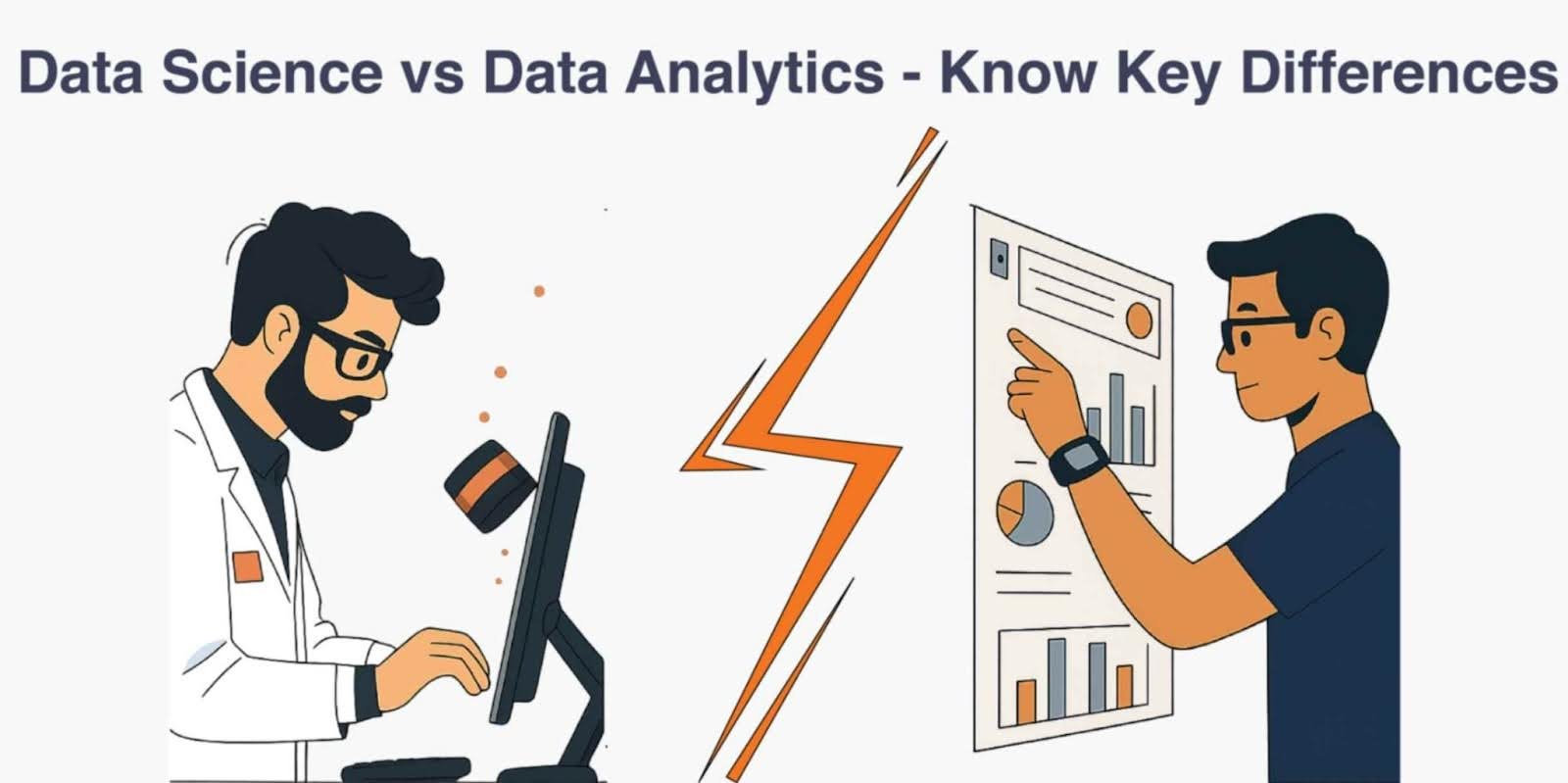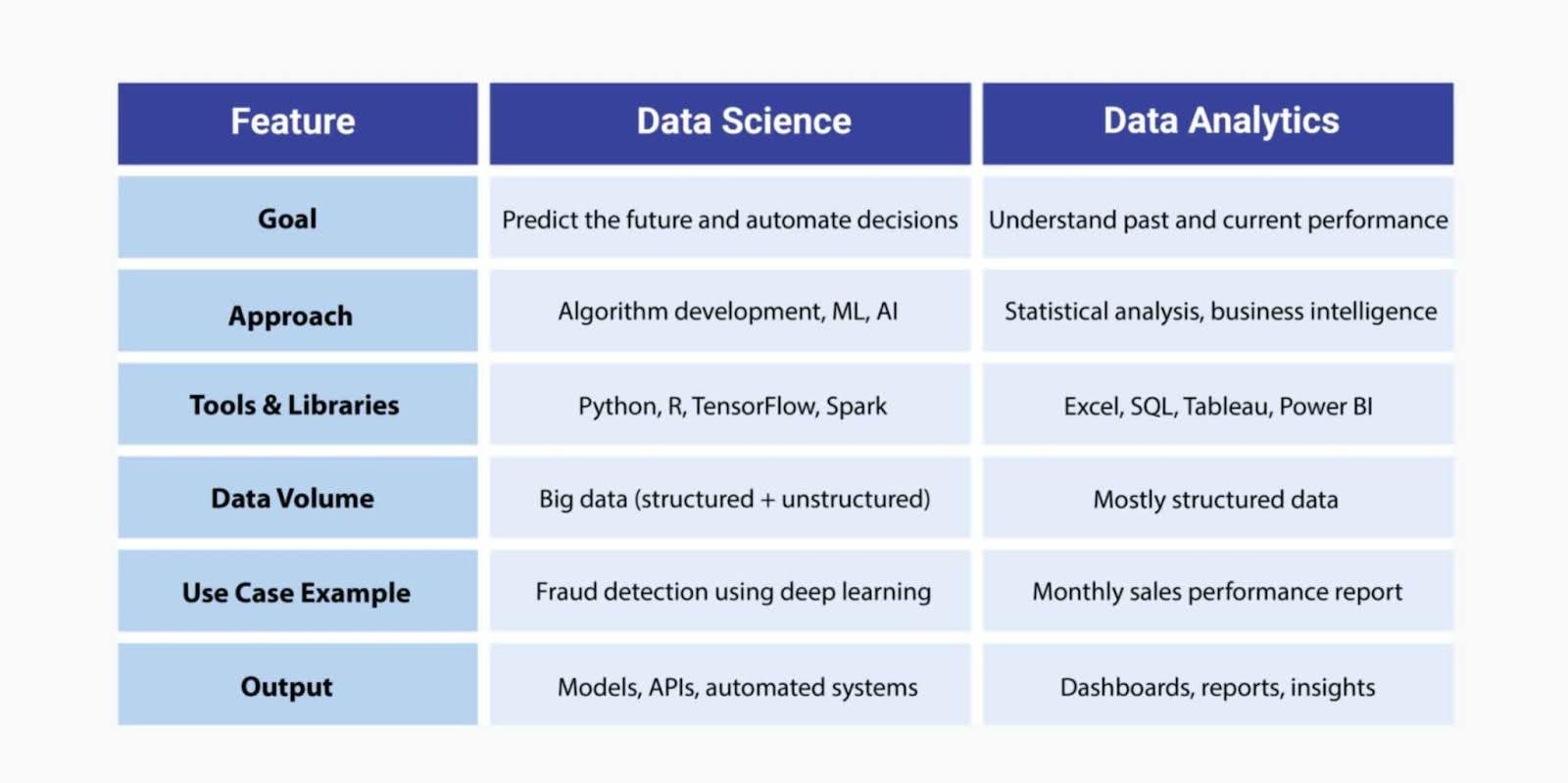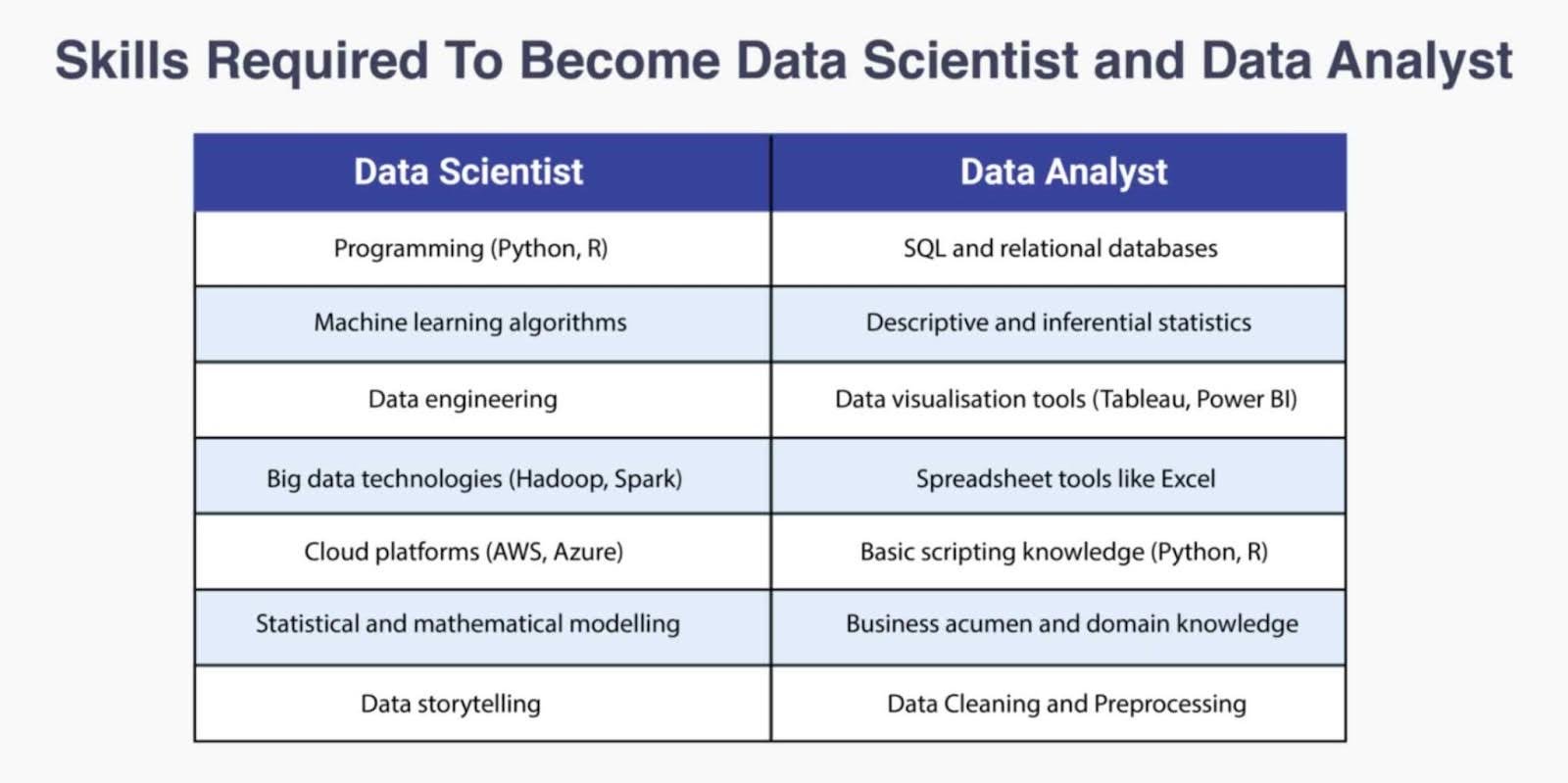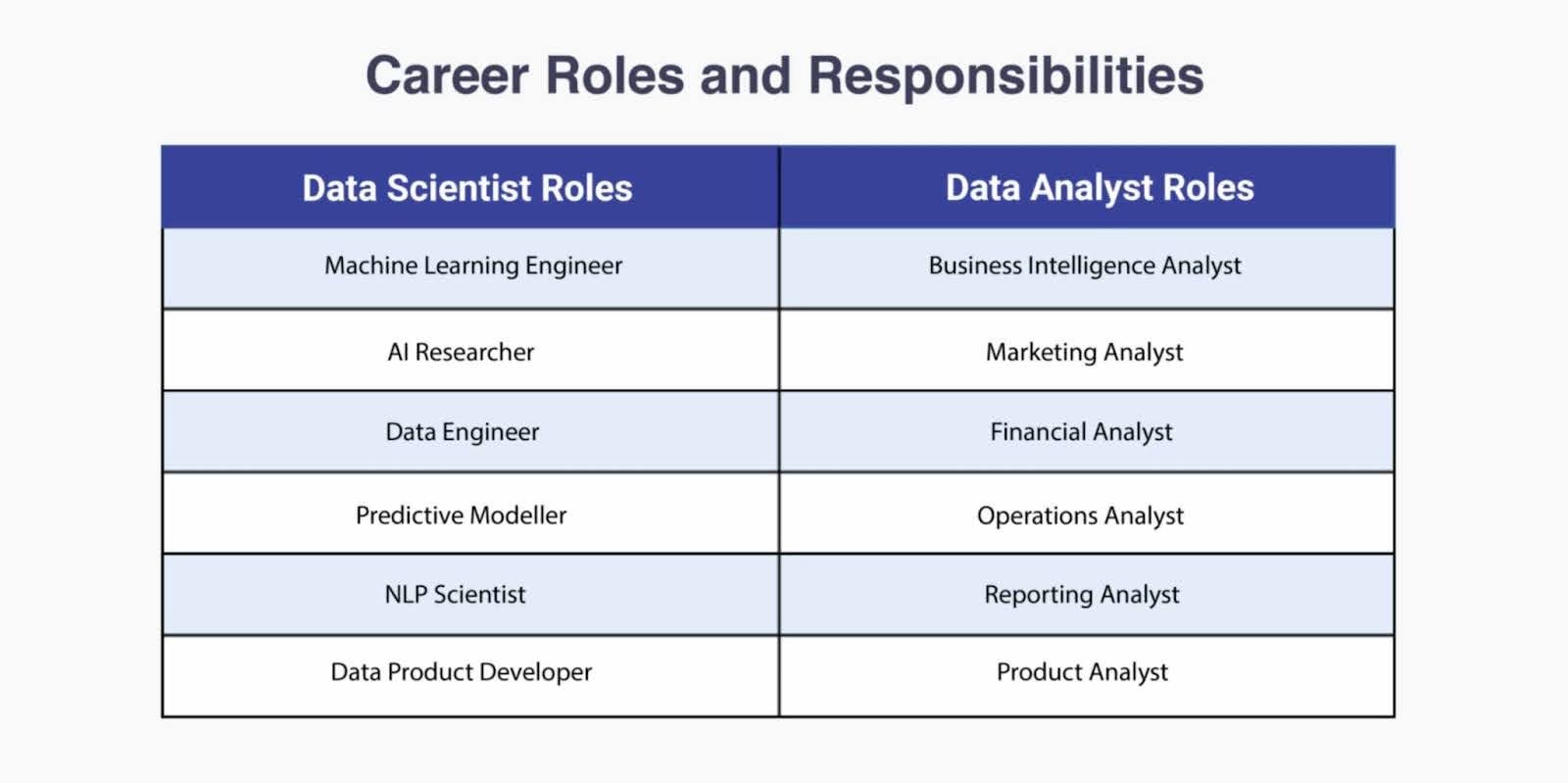What is the Difference Between Data Science and Data Analytics?

The terms "data science" and "data analytics" are often used interchangeably, but they are not the same. Both play essential roles in the data-driven decision-making process, yet they differ in scope, purpose, tools, and career paths. Knowing the difference between data science and data analytics helps organisations structure their data teams more effectively and helps individuals choose the right career direction. In this blog, we’ll clarify the difference between data science and data analytics with example use cases, explore the skills required for each, and offer guidance for those deciding between a career in data science or data analytics.
What Is Data Science?
Data science is a multidisciplinary field that uses statistical methods, programming, machine learning, and domain expertise to extract insights and build predictive models from structured and unstructured data. It involves everything from collecting raw data to developing algorithms and deploying data products. A data scientist doesn't just analyse data; they model complex scenarios, make predictions, and create tools that can automate data-driven decision-making. Their work often leads to the creation of machine learning models, recommendation engines, and forecasting systems.
Key responsibilities:
Cleaning and preprocessing large datasets
Exploratory data analysis
Developing predictive and prescriptive models
Machine learning and deep learning
Data engineering and pipeline development
Communicating technical results to stakeholders
Tools used: Python, R, SQL, TensorFlow, PyTorch, Jupyter, Apache Spark, Git
The Data Science Lifecycle
The lifecycle of a data science project involves several distinct phases:
definition – Understanding the business question
Data acquisition – Collecting and integrating data from various sources
Data preparation – Cleaning, transforming, and storing data
Exploratory analysis – Identifying patterns and correlations
Modelling – Using machine learning algorithms for prediction
Evaluation – Assessing the model's accuracy and reliability
Deployment – Implementing the model into a production environment
Monitoring – Continuously improving based on real-time feedback
Data science emphasises innovation, automation, and future forecasting based on historical patterns.
What Is Data Analytics?
Data analytics, on the other hand, focuses more on processing and performing statistical analysis on existing datasets to find actionable insights. It is typically retrospective, helping organisations understand what happened and why it happened. Analytics is more concerned with interpreting existing data to identify trends, summarise insights, and support business decision-making. It’s less focused on predictions and more on optimisation and insight generation.
Key responsibilities:
Collecting, processing, and cleaning data
Performing statistical analysis
Visualising results through dashboards and reports
Identifying performance trends and operational inefficiencies
Providing recommendations for business strategy
Tools used: Excel, Tableau, Power BI, SQL, Python (Pandas), R, Google Analytics
Types of Data Analytics
Data analytics can be broken into four main categories:
Descriptive Analytics – What happened? (e.g., sales figures)
Diagnostic Analytics – Why did it happen? (e.g., churn causes)
Predictive Analytics – What might happen? (e.g., sales forecasting)
Prescriptive Analytics – What should we do about it? (e.g., optimisation strategies)
Data scientists may operate across all four levels, but data analysts usually focus on descriptive and diagnostic analytics. When building complex data processing systems, understanding Python inheritance concepts becomes crucial for creating modular, reusable code that can be extended and maintained efficiently.
Key Differences Between Data Science and Data Analytics

Skills Required To Become Data Scientist and Data Analyst

The skill sets for both domains overlap but diverge in-depth and focus.
For Data Scientists:
Programming (Python, R)
Machine learning algorithms
Data engineering
Big data technologies (Hadoop, Spark)
Cloud platforms (AWS, Azure)
Statistical and mathematical modelling
Data storytelling
For Data Analysts:
SQL and relational databases
Descriptive and inferential statistics
Data visualisation tools (Tableau, Power BI)
Spreadsheet tools like Excel
Basic scripting knowledge (Python, R)
Business acumen and domain knowledge
While data scientists build systems that predict and learn, data analysts explain, monitor, and optimise performance.
Career Roles and Responsibilities

Data Scientist Roles:
Machine Learning Engineer
AI Researcher
Data Engineer
Predictive Modeller
NLP Scientist
Data Product Developer
Data Analyst Roles:
Business Intelligence Analyst
Marketing Analyst
Financial Analyst
Operations Analyst
Reporting Analyst
Product Analyst
The data scientist role is generally more technical, requires stronger programming and modelling skills, and commands a higher salary. However, data analytics is more approachable and essential in nearly every business sector. According to the U.S. Bureau of Labor Statistics, the demand for data science roles is expected to grow by 36% from 2023 to 2033, much faster than the average for all occupations.
Which Path Should You Choose?
Choose Data Science if:
You enjoy programming and statistics
You want to build models and develop algorithms. To build these skills effectively, start working on practical data science projects that challenge you to apply statistical concepts and programming knowledge to real-world problems.
You’re interested in AI and automation
You’re open to continuous learning in a fast-evolving field
Choose Data Analytics if:
You enjoy working with reports and dashboards
You’re good at interpreting data and providing insights
You want to make data-driven business decisions
You prefer roles that are more strategic and business-oriented
Still unsure? Start with data analytics, build a strong foundation in data handling, and gradually progress into data science training as your skills evolve.
Conclusion
So, are data science and data analytics the same? No, while they are related fields within the data domain, they serve different purposes and require different skill sets. Understanding the difference between data science and data analytics can help organisations build stronger teams and help individuals make more informed career choices. Whether you're exploring data science or data analytics, which is better depends on your interests and long-term goals. Analytics can be a great entry point, while data science offers broader challenges and higher impact through automation and AI.
For aspiring professionals seeking to establish a strong foundation, consider enrolling in structured learning programs that offer hands-on projects and practical experience. At Bhrighu Academy, our expert-led curriculum is tailored to help you master both disciplines through real-world data science projects, analytics case studies, and industry tools. Join Bhrighu Academy today and chart your career in data with confidence.
Frequently Asked Questions
Do data scientists and data analysts use the same tools?
Data scientists and data analysts share some standard tools, such as SQL, Python, and Excel, but differ in their depth of usage and application. Analysts often rely on visualization platforms like Tableau and Power BI, while data scientists use machine learning libraries such as TensorFlow, PyTorch, and Scikit-learn. The overlap exists, but data scientists typically work with more advanced programming, modeling, and big data tools than analysts.
What kind of data do these fields work with?
Data analysts primarily work with structured data from relational databases, spreadsheets, or BI tools to identify trends and support business decisions. Data scientists handle both structured and unstructured data, including text, images, and sensor data, using advanced techniques for prediction, classification, and automation. Their work often involves handling larger, more complex datasets across diverse sources.
Is data analytics a subset of data science?
Yes, data analytics is often considered a subset of data science. While data science encompasses a broader spectrum, including machine learning, data engineering, and predictive modeling, data analytics focuses on interpreting historical data to uncover patterns and insights. Analysts support business decisions through analysis, whereas data scientists may develop algorithms and systems for forecasting or automation.
Which career has higher earning potential?
Data science typically offers higher earning potential due to its advanced technical requirements, including machine learning, programming, and big data handling. According to Glassdoor, Data scientists in the US often have average salaries between $100,000 and $150,000. However, salaries depend on experience, industry, location, and skill set, with both fields offering lucrative and growing career paths.
Can data analytics lead to a career in data science?
Yes, a career in data analytics can serve as a strong foundation for transitioning into data science. Analysts gain essential skills in data cleaning, interpretation, and visualization, which are fundamental to data science. By learning programming, statistics, and machine learning, professionals can expand into data science roles. Many data scientists begin their careers as analysts and upskill over time.





